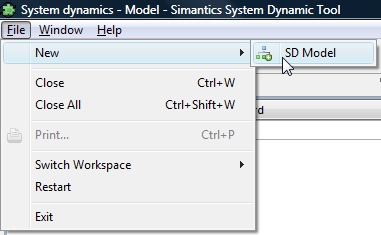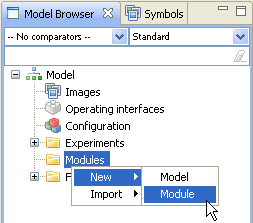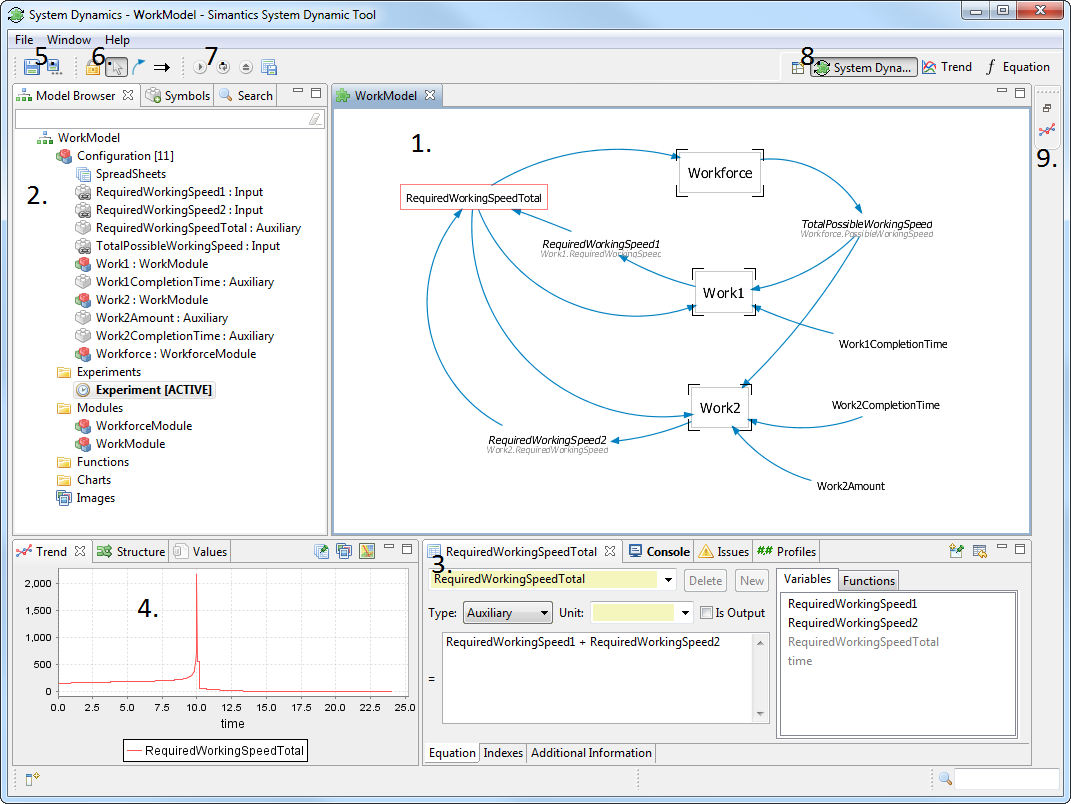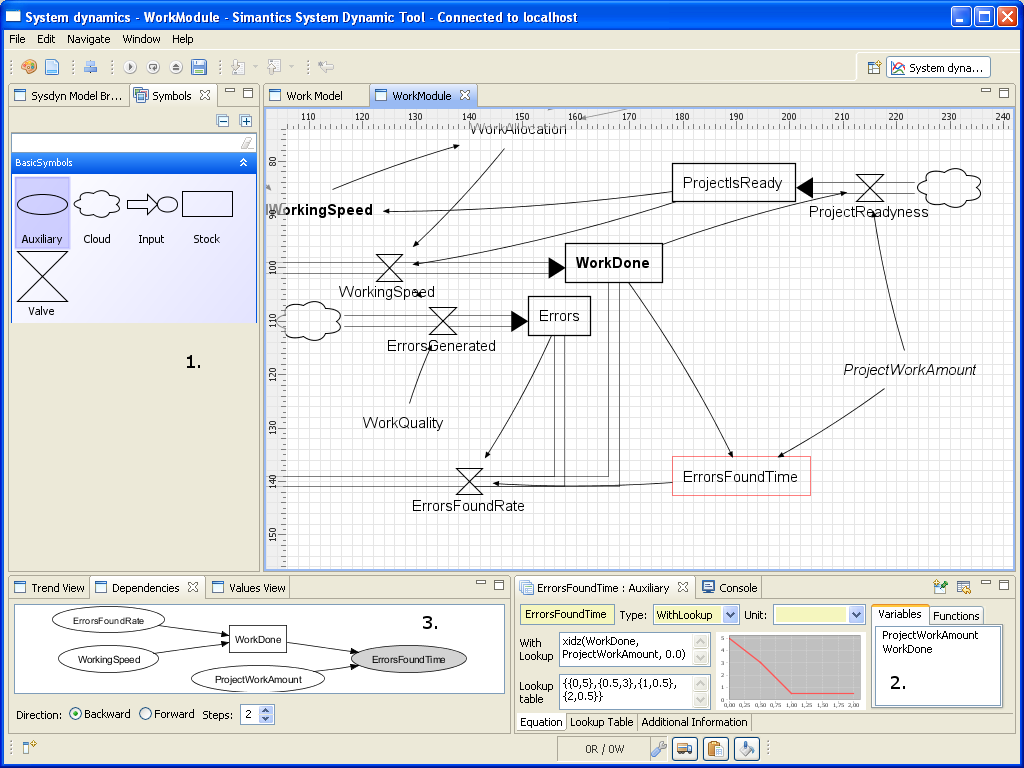Simantics System Dynamics: Difference between revisions
Jump to navigation
Jump to search
No edit summary |
|||
| Line 4: | Line 4: | ||
== System Dynamics Workbench == | == System Dynamics Workbench == | ||
[[File:BasicWorkbench.png]] | [[File:BasicWorkbench.png]] | ||
# Diagram | # '''Diagram''' <br /> Diagram is the area where you will graphically modify your model. Diagrams are built from elements that can be dragged from Symbols view or populated using shortcut keys. | ||
# Model Browser | # '''Model Browser''' <br /> Model browser shows the structure of your model and all items related to it. | ||
# | # '''Equation''' <br /> Equation view shows the selected variable's properties. Equation view has a different layout depending on the type of the selected variable. The view can also have different tabs depending on the variable type. Basic tabs are Equation and Additional information. | ||
# Trend | # '''Trend''' <br /> Trend view shows the graphical representation of the values of the selected value over time. For the trend to be shown, a simulation has to be run. The view shows always the results of the latest run, but you can save results of a simulation and show them in the same trend with results from another simulation. | ||
# Experiment controls | # '''Experiment controls''' <br /> Experiment controls are shown when an experiment is active. Experiment is activated by double clicking an experiment in the model browser. With the experiment control, you can start simulation runs and save simulation results. | ||
[[File:Modeling.png]] | [[File:Modeling.png]] | ||
# Symbols | # '''Symbols''' <br /> Symbols view shows the available symbols you can use in the diagram. The contents of the view changes according to the diagram type. When a basic system dynamics diagram is open, the view shows the basic system dynamics symbols. You can also populate symbols using shortcut keys. When using shortcut keys, the symbols view doesn't have to be open. | ||
# Equations | # '''Equations''' <br /> This is the same view as in previous screen shot. The difference is that the selected variable has type "WithLookup", which changes the layout of the view. It also adds a tab called Lookup Table, where you can determine the lookup table graphically. | ||
# Dependencies | # '''Dependencies''' <br /> Dependencies view shows which variables affect the value of the selected variable. By selecting "Forward", the view shows which variables are affected by the selected variable. | ||
== System Dynamics Modelling == | == System Dynamics Modelling == | ||
===Basic modelling=== | |||
* '''Creating a new model''' <br /> Start a new model by right-clicking the model browser and selecting New->Model or from the main menu File->New Model. [[File:Basic_1.png]] | |||
* '''Creating a new module type''' <br /> Create a new module type by right-clicking on the Modules-folder and selecting New->Module. This creates a new module type that you can populate to your other modules and the model configuration. [[File:Basic_2.png]] | |||
* '''Configuring a model''' <br /> Model configuration can be opened by double clicking Configuration in the model browser. | |||
* '''Configuring modules''' <br /> Configuration of a module type can be opened by double clicking the module type you want to configure. You can also open the configuration of a module from a diagram, when a module has been populated to that diagram, by right-clicking the module and selecting Show Module. When opening modules from diagram, the opened diagram knows to which diagram the module has been populated and can show the connections between the modules. Keep in mind that when making changes to a module, the changes apply to all instances of the module! | |||
* '''Populate variables''' <br /> You can drag variables to a diagram from symbol view. You can also populate variables using [[#Shortcut and control keys|shortcut keys]] | |||
* '''Populate modules''' <br /> Modules are populated from the model browser. Just drag the module you want to populate from the Modules folder to a diagram. | |||
* '''Configure variables''' <br /> Select a single variable from diagram or model browser. The properties of the variables are shown in the equation view and you can modify them. | |||
* '''Simulate model''' <br /> To simulate a model, you need to activate an experiment. Browse to an experiment in you model browser and double click on the experiment. Experiment controls appear to the main tool bar. Click on the play button to run a simulation. | |||
===Other features=== | |||
===Shortcut and control keys=== | |||
{| | |||
|Shift + A | |||
|Hover Auxiliary at the cursor position, populate with left mouse button. | |||
|- | |||
|Shift + S | |||
|Hover Stock at the cursor position, populate with left mouse button. | |||
|- | |||
|Shift + C | |||
|Hover Cloud at the cursor position, populate with left mouse button. | |||
|- | |||
|Shift + V | |||
|Hover Valve at the cursor position, populate with left mouse button. | |||
|- | |||
|Shift + I | |||
|Hover Input at the cursor position, populate with left mouse button. | |||
|- | |||
|Alt + left mouse button | |||
|Start an arrow from a variable. End to another variable by clicking left mouse button. | |||
|- | |||
|Alt + right mouse button | |||
|Start flow from a variable. End by clicking left mouse button. | |||
If a flow is not started or ended on to a variable, a cloud will be created to that end. <br /> | |||
If a new flow does not have a valve at either end, a valve will be created in the middle of the flow. | |||
|- | |||
|Delete | |||
|Remove selected variables | |||
|- | |||
|Ctrl + left mouse button | |||
|Select multiple variables | |||
|- | |||
|Mouse wheel or<br/>+ and - | |||
|Diagram zoom | |||
|- | |||
|drag(mouse3) or<br/>drag(shift + any mouse button) | |||
|Diagram pan | |||
|- | |||
|Ctrl + Z | |||
|Undo diagram action | |||
|- | |||
|Ctrl + Y | |||
|Redo diagram action | |||
|- | |||
|Ctrl + C | |||
|Copy selected elements | |||
|- | |||
|Ctrl + X | |||
|Cut selected elements | |||
|- | |||
|Ctrl + V | |||
|Paste copied or cut elements | |||
|} | |||
== System Dynamics Simulation == | == System Dynamics Simulation == | ||
Revision as of 10:58, 21 September 2010
Introduction to System Dynamics Simulation
Text...
System Dynamics Workbench
- Diagram
Diagram is the area where you will graphically modify your model. Diagrams are built from elements that can be dragged from Symbols view or populated using shortcut keys. - Model Browser
Model browser shows the structure of your model and all items related to it. - Equation
Equation view shows the selected variable's properties. Equation view has a different layout depending on the type of the selected variable. The view can also have different tabs depending on the variable type. Basic tabs are Equation and Additional information. - Trend
Trend view shows the graphical representation of the values of the selected value over time. For the trend to be shown, a simulation has to be run. The view shows always the results of the latest run, but you can save results of a simulation and show them in the same trend with results from another simulation. - Experiment controls
Experiment controls are shown when an experiment is active. Experiment is activated by double clicking an experiment in the model browser. With the experiment control, you can start simulation runs and save simulation results.
- Symbols
Symbols view shows the available symbols you can use in the diagram. The contents of the view changes according to the diagram type. When a basic system dynamics diagram is open, the view shows the basic system dynamics symbols. You can also populate symbols using shortcut keys. When using shortcut keys, the symbols view doesn't have to be open. - Equations
This is the same view as in previous screen shot. The difference is that the selected variable has type "WithLookup", which changes the layout of the view. It also adds a tab called Lookup Table, where you can determine the lookup table graphically. - Dependencies
Dependencies view shows which variables affect the value of the selected variable. By selecting "Forward", the view shows which variables are affected by the selected variable.
System Dynamics Modelling
Basic modelling
- Creating a new model
Start a new model by right-clicking the model browser and selecting New->Model or from the main menu File->New Model.
- Creating a new module type
Create a new module type by right-clicking on the Modules-folder and selecting New->Module. This creates a new module type that you can populate to your other modules and the model configuration.
- Configuring a model
Model configuration can be opened by double clicking Configuration in the model browser. - Configuring modules
Configuration of a module type can be opened by double clicking the module type you want to configure. You can also open the configuration of a module from a diagram, when a module has been populated to that diagram, by right-clicking the module and selecting Show Module. When opening modules from diagram, the opened diagram knows to which diagram the module has been populated and can show the connections between the modules. Keep in mind that when making changes to a module, the changes apply to all instances of the module! - Populate variables
You can drag variables to a diagram from symbol view. You can also populate variables using shortcut keys - Populate modules
Modules are populated from the model browser. Just drag the module you want to populate from the Modules folder to a diagram. - Configure variables
Select a single variable from diagram or model browser. The properties of the variables are shown in the equation view and you can modify them. - Simulate model
To simulate a model, you need to activate an experiment. Browse to an experiment in you model browser and double click on the experiment. Experiment controls appear to the main tool bar. Click on the play button to run a simulation.
Other features
Shortcut and control keys
| Shift + A | Hover Auxiliary at the cursor position, populate with left mouse button. |
| Shift + S | Hover Stock at the cursor position, populate with left mouse button. |
| Shift + C | Hover Cloud at the cursor position, populate with left mouse button. |
| Shift + V | Hover Valve at the cursor position, populate with left mouse button. |
| Shift + I | Hover Input at the cursor position, populate with left mouse button. |
| Alt + left mouse button | Start an arrow from a variable. End to another variable by clicking left mouse button. |
| Alt + right mouse button | Start flow from a variable. End by clicking left mouse button.
If a flow is not started or ended on to a variable, a cloud will be created to that end. |
| Delete | Remove selected variables |
| Ctrl + left mouse button | Select multiple variables |
| Mouse wheel or + and - |
Diagram zoom |
| drag(mouse3) or drag(shift + any mouse button) |
Diagram pan |
| Ctrl + Z | Undo diagram action |
| Ctrl + Y | Redo diagram action |
| Ctrl + C | Copy selected elements |
| Ctrl + X | Cut selected elements |
| Ctrl + V | Paste copied or cut elements |
System Dynamics Simulation
Text...
Getting Started with Simantics | Project Management | Discrete Event System Modelling | System Dynamics Modelling | Ontology Development

Tutorial: System Dynamics Modelling
System dynamics modelling in Simantics is another free domain specific modelling tool that is included into the basic installation. This tutorial introduces the basic features of the system dynamcics modelling tools.

